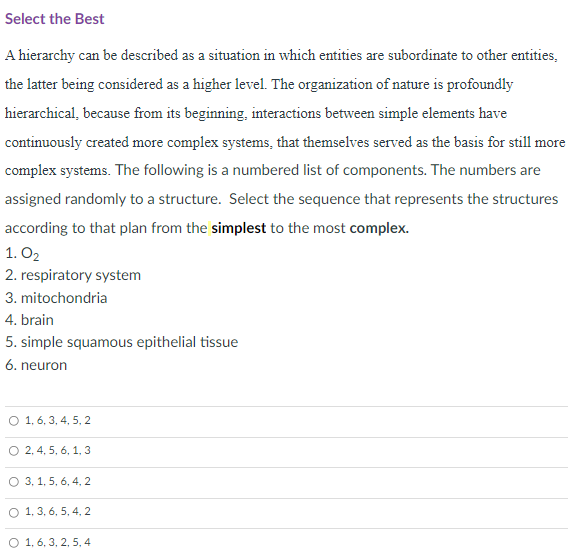A hierarchy can be described as a situation in which entities are subordinate to other entities, the latter being considered as a higher level. The organization of nature is profoundly hierarchical, because from its beginning, interactions between simple elements have continuously created more complex systems, that themselves served as the basis for still more complex systems. The following is a numbered list of components. The numbers are assigned randomly to a structure. Select the sequence that represents the structures according to that plan from the simplest to the most complex. 1. O2 2. respiratory system 3. mitochondria 4. brain 5. simple squamous epithelial tissue 6. neuron O 1, 6, 3, 4, 5, 2 O 2, 4, 5, 6, 1, 3 O 3, 1, 5, 6, 4, 2 O 1, 3, 6, 5, 4, 2 O 1, 6, 3, 2, 5,4
A hierarchy can be described as a situation in which entities are subordinate to other entities, the latter being considered as a higher level. The organization of nature is profoundly hierarchical, because from its beginning, interactions between simple elements have continuously created more complex systems, that themselves served as the basis for still more complex systems. The following is a numbered list of components. The numbers are assigned randomly to a structure. Select the sequence that represents the structures according to that plan from the simplest to the most complex. 1. O2 2. respiratory system 3. mitochondria 4. brain 5. simple squamous epithelial tissue 6. neuron O 1, 6, 3, 4, 5, 2 O 2, 4, 5, 6, 1, 3 O 3, 1, 5, 6, 4, 2 O 1, 3, 6, 5, 4, 2 O 1, 6, 3, 2, 5,4
Chapter3: Solving Common Fraction Equations
Section: Chapter Questions
Problem 3.9P
Related questions
Question
I'm not sure which one is best

Transcribed Image Text:Select the Best
A hierarchy can be described as a situation in which entities are subordinate to other entities,
the latter being considered as a higher level. The organization of nature is profoundly
hierarchical, because from its beginning, interactions between simple elements have
continuously created more complex systems, that themselves served as the basis for still more
complex systems. The following is a numbered list of components. The numbers are
assigned randomly to a structure. Select the sequence that represents the structures
according to that plan from the simplest to the most complex.
1. O2
2. respiratory system
3. mitochondria
4. brain
5. simple squamous epithelial tissue
6. neuron
O 1, 6, 3, 4, 5, 2
O 2, 4, 5, 6, 1, 3
O 3, 1, 5, 6, 4, 2
O 1, 3, 6, 5, 4, 2
O 1, 6, 3, 2, 5,4
Expert Solution
This question has been solved!
Explore an expertly crafted, step-by-step solution for a thorough understanding of key concepts.
Step by step
Solved in 2 steps

Recommended textbooks for you


Biology Today and Tomorrow without Physiology (Mi…
Biology
ISBN:
9781305117396
Author:
Cecie Starr, Christine Evers, Lisa Starr
Publisher:
Cengage Learning


Biology Today and Tomorrow without Physiology (Mi…
Biology
ISBN:
9781305117396
Author:
Cecie Starr, Christine Evers, Lisa Starr
Publisher:
Cengage Learning